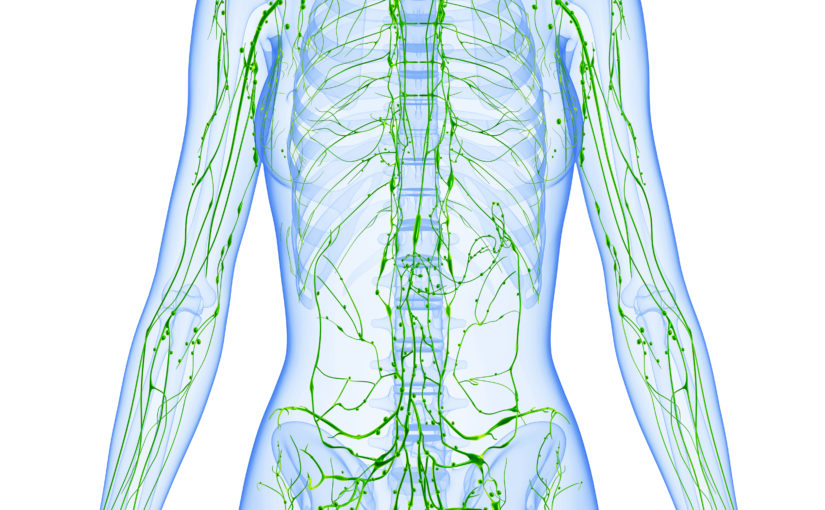Lymph Drainage Therapy is a gentle manual therapy that uses exacting anatomical science and specific massage techniques to stimulate the movement of lymph through the one-way drainage pathways within the body. The therapist assesses the rhythm, direction, depth and quality of the lymph flow in the body to determine the best pathway for draining the body of metabolic waste products, excess fluids, and bacteria.
Lymph
Lymph is a watery or milky fluid that originates as plasma, which is the fluid portion of blood. Blood and lymph have a similar transport network, but don’t directly cross over into one another’s territories. Blood remains in the blood vessels and lymph in the lymph vessels. The arterial blood flowing out of the heart slows as it moves through the capillary bed. This slowing allows some plasma to leave the arterioles and flow into the tissues between the cells. This fluid delivers nutrients, oxygen, and hormones to the cells. As this fluid leaves the cells, it takes with it cellular waste products and protein cells. Approximately 90 percent of this tissue fluid flows into the venules. Here it enters the venous circulation as plasma and continues in the circulatory system. The remaining 10 percent of the fluid that is left behind is now known as lymph. Lymph is similar to blood plasma but contains more white blood cells. There are about 1-2 liters of lymph fluid in the average body and all body tissues are bathed in lymph.
Lymph Nodes
There are approximately 600 to 700 lymph nodes in the body. They vary in size from microscopically small to about 2.5 cm across. They lie mainly in groups around the armpit, groin, breasts and major blood vessels of the abdomen and chest. The role of these nodes is to filter the lymph before it is returned to the circulatory system. Although these nodes can increase or decrease in size throughout life, any node that has been damaged or destroyed does not regenerate. Lymph nodes filter out harmful substances such as bacteria. The monocytes (white blood cells), destroy foreign organisms. Lymphocytes produce antibodies. When there is an infection, the nodes produce more lymphocytes thus the nodes can become enlarged.
The lymphatic system does not have a pump to aid in its flow, instead this system is designed so that lymph only flows upward through the body traveling from the extremities and upward through the body toward the neck. As it travels through the body, lymph passes through lymph nodes where it is filtered. At the base of the neck, the lymph enters the subclavian veins and once again becomes plasma in the bloodstream.
Lymphatic System
The lymphatic system is part of the body’s immune system which provides defense against disease-causing organisms. The lymphatic system is composed of lymph vessels, lymph nodes, and organs. It absorbs fluid, macro-molecules, microorganisms, toxins, and metabolic waste products from the interstitial tissue. Numerous excess substances (electrolytes, proteins, hormones, toxins, debris) and immuno-competent cells (lymphocytes, macrophages) pass through the regional lymph nodes, where lymph fluid is filtered, purified, and concentrated.
The lymphatic flow can stagnate for many reasons, such as swelling, chronic inflammation, lack of physical activity, stress, fatigue, emotional shock, advanced age, or poorly fitted bras and bras worn for an excessive amount of time. When lymphatic circulation slows down or becomes blocked, the regeneration of cells becomes less robust. Stagnant lymph circulation allows toxins and proteins to accumulate around cells, causing cellular oxygenation to decrease and tissue regeneration to diminish, which can affect white blood cell counts.
The lymphatic system does not have a pump like the heart but relies on the movement of the body and the contraction of the skeletal muscles to propel lymph though the vessels to lymph nodes and then beyond the nodes to the lymph ducts which return lymph to the cardiovascular system. This squeezing action of the muscles forces the lymph along its vessels. Lymphatic drainage therapy reproduces this action to benefit and increase overall health and well being. Lymphatic drainage is believed to reduce blockage which promotes health in the lymphatic system as well as the circulatory, respiratory, muscular, and endocrine systems.
Functions of the Lymphatic System
- Drains excess fluid from the tissues, preventing edema (swelling)
- Fights infection by filtering out micro-organisms through the lymph nodes and by lymphocytes producing antibodies.
- Supports the immune system.
- Carries protein molecules that are too large to pass through the blood capillary walls back to the blood stream.
- Removes waste materials from the body’s cells.
- Absorbs the products of fat digestion from the villi of the small intestine.
- Provides a constant exchange with the blood to deliver nutrients, oxygen and hormones and remove waste.

